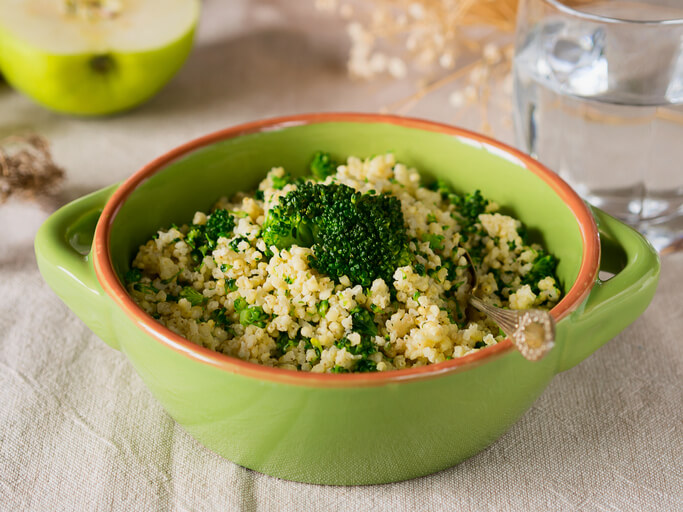Millet. The ‘Bird Seed’ You Might Want To Try!

Now that we are in the thick of fall and winter will be here before we know it, I’m on the hunt for hearty but healthy foods I can add to my shopping list for home cooked meals. I recently came across millet in the same aisle of the grocery store where I get my quinoa and brown rice. I didn’t know much about millet, so I did some research.
Millet is actually a very common ingredient in bird seed mixes. As unsexy as that may sound, hear me out. Cheaper than quinoa and reportedly one of the most abundant crops grown in India and Africa, millet is a seed belonging to the Poaceae plant family (more commonly known as the grass family).
It can be a bit confusing, because millet is usually referred to as a grain (not a seed). To provide some clarity, “Cereal grains ― which include oats, wheat, rice, corn, barley, rye, sorghum and millet ― are the edible seeds of specific grasses belonging to the Poaceae family,” according to one report.

So let’s just call millet a grain like most people do. You cook it similar to other grains such as rice and quinoa. Once cooked, it’s fluffy, light texture is so inviting. And it’s pretty mild in flavor (some say it tastes like corn), so you can season it and basically give millet any kind of flavor that you would like. When you cook millet, this is a great time to utilize spices and herbs such as cayenne pepper, cumin, saffron, mint, parsley, turmeric and more.
Millet can also be a great addition to soups and stews (perfect for fall and winter). Check out this recipe for vegetable soup with millet.
It is gluten-free and sometimes used to make gluten-free breads and other products for people who are unable to or prefer not to consume gluten. There is millet flour available for gluten-free baking.
Reportedly, millet is one of the earliest cultivated grains and more than 6,000 varieties grow around the world! Although there are thousands of varieties, there are a select few readily available for human consumption.
“The five millet species commonly grown as commercial crops are proso, foxtail, pearl, Japanese barnyard and browntop — although there are many other types,” reports University of California, Berkeley.
(Many millet varieties are also drought-tolerant which is great).
In addition to being gluten-free, millet is high in protein and antioxidants and has a low glycemic index (GI) which may make it a great food for helping manage diabetes. Foods with a low GI help balance blood sugar levels and may keep you feeling full for a longer period of time.
“Indeed, there are evidences to support that millets have many properties making it a good dietary option for diabetics. For an example, an experiment that has used diabetic mice to test different diets has concluded that added millet protein can increase insulin sensitivities, and reduce blood glucose level as well as triglyceride level,” reports the National Institutes of Health (NIH).
Millet is also very nutrient-dense.
For example (per Food Tank):
- Finger millet has three times more calcium than milk.
- Kodo millet has three times the dietary fiber of wheat and maize, and ten times that of rice.
Furthermore, U.C. Berkeley reports, “Different members of the millet family contain different portfolios of nutrients — millet grains often contain lower carbohydrates as compared to rice, corn or wheat, and higher levels of proteins, fiber and certain minerals such as calcium, magnesium, phosphorus and iron.”
Millet may have anti-cancer properties.
A study published by the National Institutes of Health (NIH) provided evidence which showed that foxtail millet “displayed profound inhibitory effects on the growth of human colon cancer cells, but not on that of the normal colon epithelial cells.”
In addition to this, the fiber in any kind of millet may help decrease the risk of developing colorectal cancer and help people who have already been diagnosed with colorectal cancer.
Millet may help prevent anemia that can occur during pregnancy.
“Barnyard millet and pearl millet are a rich source of iron, and their consumption can meet the iron requirements of pregnant women suffering from anaemia,” according to one source.
Millet may lower your risk of heart disease.
Millet and other whole grains may help lower cholesterol levels and reduce chronic inflammation, which has been linked to the development of both cancer and heart disease. This grain is also rich in heart-friendly minerals such as magnesium, calcium and potassium.
Millet may help maintain muscle and nerve health.
As mentioned, millet is a good source of the mineral magnesium.
Magnesium is one of the major minerals inside our bodies’ cells. Outside the cells, it is an important cofactor for hundreds of processes and reactions in the body, including energy. It is important in sugar breakdown and use, blood pressure regulation and muscle and nerve function (including the heart muscle).
A tip when preparing millet.
There is evidence which suggests that sprouting millet as opposed to cooking it may help preserve more of the nutrients in this grain.
Precautions with millet?
There is some evidence that millet, particularly pearl millet, may interfere with thyroid function. So if you have any thyroid issues, speak with a competent healthcare professional about whether it is safe to include millet in your diet. And as always, if you are pregnant or breastfeeding, taking any medications or have any existing health issues, it is recommended to seek medical advice regarding what foods you are including in your daily diet.
Enjoy your healthy life!
The pH professional health care team includes recognized experts from a variety of health care and related disciplines, including physicians, attorneys, nutritionists, nurses and certified fitness instructors. This team also includes the members of the pH Medical Advisory Board, which constantly monitors all pH programs, products and services. To learn more about the pH Medical Advisory Board, click here.







